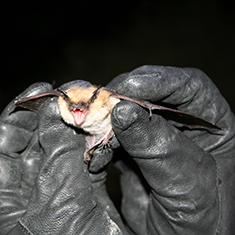
Bowman announced it was awarded a contract by the National Renewable Energy Laboratory (NREL) to conduct research on how bat populations behave around wind turbines with the goal of understanding why bat mortalities occur to inform reduction strategies. With funding by the U.S. Department of Energy Wind Energy Technologies Office, the NREL Enabling Coexistence Options for Wind Energy and Wildlife (ECO Wind) program selected three companies to support the complex research project with each firm receiving a portion of a $1.1 million total research fund.
“As the global human population continues to grow, so does our need for renewable energy sources like solar and wind energy,” states Bowman’s Natural Resources Team Lead and Ecologist Dr. Sara Weaver. “Unfortunately, when it comes to wind energy development, bat mortalities are an unforeseen consequence and of particular concern. The wind energy industry recognizes the importance of these unique animals and has been working toward solutions to improve the coexistence of wildlife and wind turbines.”
NREL’s ECO Wind program is focused on protecting vulnerable wildlife species while ensuring maintainable deployment of wind energy developments. Many experts hypothesize on the causes for bat mortalities at wind turbines with most suggesting an unexplained attraction to the structures for reasons such as roosting, mating, socializing and/or foraging.
“Our understanding of these behaviors is still in its infancy and warrants further investigation through research programs like this,” added Weaver.
Bowman will be teaming with Wildlife Imaging Systems, which provides advanced computer vision and machine learning solutions for the wildlife research community, to provide a comprehensive study to characterize bat flight patterns near wind turbines and investigate how various bat species behave in different geographic regions. Utilizing thermal video footage collected at the sites, the team will compare bat behavior and collision events at wind energy facilities in Minnesota and Texas.
During the two-year study, the teams will provide regular progress reports and a final report of findings at the end of the study, which will be made publicly accessible through scientific publications and virtual webinars.



